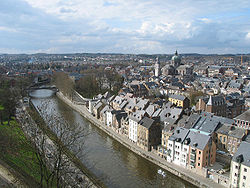| Sambre | |
|---|---|
 The Sambre in the centre of Namur | |
 | |
| Location | |
| Countries | Belgium and France |
| Physical characteristics | |
| Source | |
| • location | Picardy |
| • elevation | 199 m (653 ft) |
| Mouth | |
• location | Meuse at Namur |
• coordinates | 50°27′43″N 4°52′15″E / 50.46194°N 4.87083°E |
| Length | 193 km (120 mi) |
| Basin size | 2,740 square kilometres (1,060 sq mi) |
| Basin features | |
| Progression | Meuse→ North Sea |
The Sambre (French: [sɑ̃bʁ]) is a river in northern France and in Wallonia, Belgium. It is a left-bank tributary of the Meuse, which it joins in the Wallonian capital Namur.
The source of the Sambre is near Le Nouvion-en-Thiérache, in the Aisne department. It passes through the Franco-Belgian coal basin, formerly an important industrial district. The navigable course begins in Landrecies at the junction with the Canal de la Sambre à l'Oise, which links with the central French waterway network (or did, until navigation was interrupted in 2006 following structural failures).[1] It runs 54 km and 9 locks 38.50m long and 5.20m wide down to the Belgian border at Jeumont. From the border the river is canalised in two distinct sections over a distance of 88 km with 17 locks. The Haute-Sambre is 39 km long and includes 10 locks of the same dimensions as in France, down to the industrial town of Charleroi. The rest of the Belgian Sambre was upgraded to European Class IV dimensions (1350-tonne barges) in the immediate post-World War II period. It lies at the western end of the sillon industriel, which is still Wallonia's industrial backbone, despite the cessation of all the coal-mining and a decline in the steel industry. The river flows into the Meuse at Namur, Belgium.
The navigable waterway is managed in France by Voies Navigables de France and in Belgium by the Service Public Wallon - Direction générale opérationnelle de la Mobilité et des Voies hydrauliques (Operational Directorate of Mobility and Inland Waterways)[2]
- ^ Edwards-May, David (2010). Inland Waterways of France. St Ives, Cambs., UK: Imray. pp. 246–249. ISBN 978-1-846230-14-1.
- ^ Edwards-May, David (2014). European Waterways Map and Concise Directory. Lambersart, France: Transmanche. pp. 11–12, 17–20 and fold-out map. ISBN 979-10-94429-00-6.